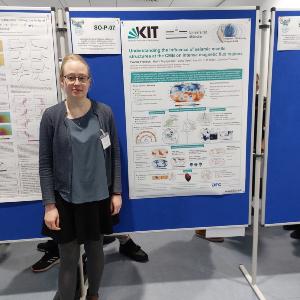Influence of deep mantle structures on intense magnetic flux regions
Understanding the influence of deep seismic mantle structures at the core-mantle boundary on intense magnetic flux regions
Understanding the influence of deep seismic mantle structures at the core-mantle boundary on intense magnetic flux regions
The Earth's magnetic field, generated in the outer core, is characterized by variations on many time scales. While there are short-time variations such as westward moving intense flux areas near the equator and reverse flux patches, long-term stable areas of intense magnetic flux are sustained in other regions. Two of those intense high flux regions are found in the northern hemisphere, beneath Siberia and Canada and there is a prediction for a third one in the North Atlantic. There is some consensus that structure in the Earth's lower mantle presents a boundary condition for the Earth’s magnetic field and previously, seismic tomography models have been used to understand the interaction between mantle structure and core dynamics. In this proposal we aim to investigate mantle structure near the interface between core and mantle, i.e., the core-mantle boundary (CMB), with the intent to establish 1) the seismic velocity contrast to the surrounding mantle around high flux regions, 2) the extend and anisotropy of the structure, and 3) which minerals are constituents of the structures. Following this we will construct maps of thermal and electrical conductivity at selected spots close to the CMB which are a necessary boundary condition for the numerical modelling of core dynamics. We will concentrate on four regions: The two visible regions and one proposed region of intense magnetic flux in the northern hemisphere (Siberia, Canada and the North Atlantic) as well as the region beneath Indonesia where intense flux patches at the equator seem to start moving rapidly westwards. We will use seismic reflections of P- and S-waves as well as converted waves (P-to-S and S-to-P) off structures near the CMB, such as the top of the D" region, ultra-low velocity zones, and other reflectors. We will extract seismic attributes, such as amplitude, waveform, polarities of the reflected waves and compare these with synthetically modelled data. We will also measure and model shear wave splitting to study anisotropy in the same regions where we detect reflections. Using minerals that are likely present in the lowermost mantle, we will use their elastic parameters and calculate deformation and texture, which will provide directionally dependent velocities. These velocities will then be used to calculate reflection and transmission coefficients of seismic waves at the reflectors and anisotropic characteristics. Using seismic reflections and splitting together with the deformation modelling will allow us to determine the most likely mineral for the investigated structure. In a collaboration with mineral physics groups in DeepDyn, we will then provide maps of thermal and electrical conductivities at the CMB which in turn can then be used as boundary condition for core modelling within DeepDyn.

A glimpse into the depths of places with unusually strong geomagnetic flux density

Deep down in the earth, at the border between the mantle and the core, special structures lie hidden.

Seismic structures at the CMB